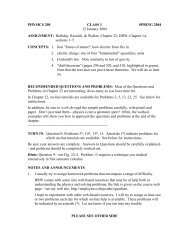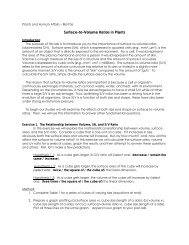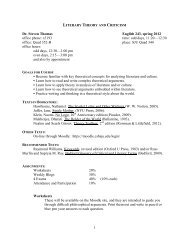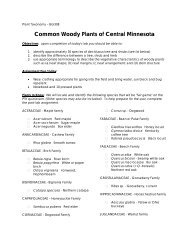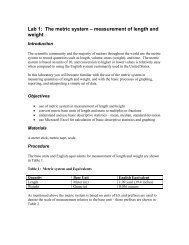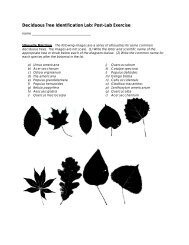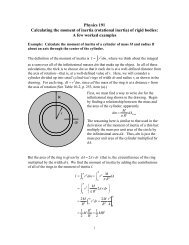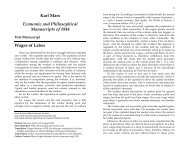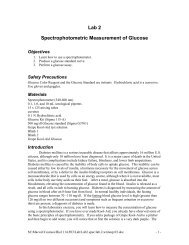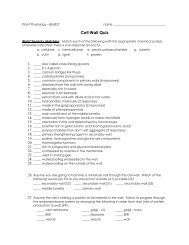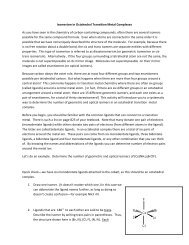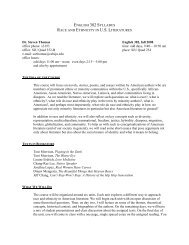Lucas et al. / MARITAL SATISFACTION INVARIANCE 115TABLE 2MARQ Scale Internal ConsistenciesScale Items Group AlphaLove 9 American husbands .91American wives .91British husbands .89British wives .91Chinese husbands .87Chinese wives .86Turkish husbands .87Turkish wives .89Partnership 9 American husbands .90American wives .91British husbands .87British wives .90Chinese husbands .88Chinese wives .88Turkish husbands .86Turkish wives .86NOTE: MARQ = Marriage and Relationships Questionnaire.Usually, configural equivalency determines a baseline model <strong>of</strong> invariance by providing aplatform for next assessing metric invariance, the second requirement <strong>of</strong> structural equivalency(Vandenberg & Lance, 2000). Metric invariance is generally equated with strongfactorial invariance and is more restrictive than configural invariance in requiring equivalentitem loadings (i.e., factor scores for a given item are equivalent across groups).Historically, researchers have suggested that the means <strong>of</strong> the latent variables can becompared across groups once metric invariance has been established (Cheung & Rensvold,1999). However, more recent recommendations (e.g., Byrne, 2001) have suggested thatintercept invariance may also be required for structural equivalency. We thereforeemployed a third requirement <strong>of</strong> structural equivalency by assessing not only configuraland metric invariance but also the equivalency <strong>of</strong> item intercepts. In cases where all threerequirements <strong>of</strong> structural equivalency were met, we examined one final form <strong>of</strong> invarianceby examining the equivalency <strong>of</strong> latent variable means. Thus, although our primaryanalyses related to the equivalency <strong>of</strong> structure in our measures <strong>of</strong> marital satisfaction, wealso examined equivalency <strong>of</strong> level in cases where structure was invariant.We examined the invariance <strong>of</strong> each <strong>of</strong> our four marital satisfaction measures usingcovariance structure analyses. All analyses were performed using LISREL 8.30 (Jöreskog& Sörbom, 1999) and maximum likelihood estimation. In all instances, scale restrictionwas imposed by constraining the latent variable variances to one. Because <strong>of</strong> our largesample sizes, we expected that the normal weighted theory chi-square statistic would besignificant (Marsh, Balla, & McDonald, 1988). We therefore examined several additionalfit indices, including the nonnormed fit index (NNFI; Bentler & Bonett, 1980), the comparativefit index (CFI; Bentler, 1990; Satorra & Bentler, 1994), and the root mean squareerror <strong>of</strong> approximation (RMSEA; Browne & Cudeck, 1993). Values <strong>of</strong> .90 or higher arethought to indicate good overall fit for the NNFI and the CFI, whereas values up to .08 aregenerally considered acceptable for the RMSEA.Invariance testing requires an assessment <strong>of</strong> changes in overall model fit that occurwhen restricted models impose additional equivalency constraints on items. Generally,Downloaded from http://jcc.sagepub.com at College <strong>of</strong> St. Benedict/St. John's University on April 10, 2008© 2008 SAGE Publications. All rights reserved. Not for commercial use or unauthorized distribution.
116 JOURNAL OF CROSS-CULTURAL PSYCHOLOGYa chi-square difference test is used, and invariance is established when the imposed equivalencies<strong>of</strong> metric, intercept, and slope invariance do not significantly reduce the fit <strong>of</strong> aprevious model (Rensvold & Cheung, 1998; Steiger, Shapiro, & Browne, 1985). However,because chi-square tests are susceptible to sample size and degrees <strong>of</strong> freedom, we concludedinvariance when changes in the CFI <strong>of</strong> .01 or less were observed in a more stringentlyconstrained model (Cheung & Rensvold, 1999), whereas additional fit indicescontinued to suggest a generally good overall fit (Little, 1997).We assessed equivalency using two sets <strong>of</strong> covariance structure equality tests. In the firstset, we assessed invariance between husbands and wives within each <strong>of</strong> the four cultures (i.e.,spousal invariance). Similar to time-series covariance analyses, we allowed the residual terms<strong>of</strong> husbands and wives to correlate for parallel items. In the second set, we assessed invarianceacross same-gendered spouses from all four cultures (i.e., cultural invariance). For bothspousal and cultural invariance, we concluded configural invariance if an initially unconstrainedmodel fit well. We then ran additional models in which item loadings, intercepts, andmeans were incrementally constrained to be equal across groups (e.g., corresponding itemloadings equal for wives across all four cultures). If overall fit was retained in a more constrainedmodel, we concluded that invariance could be ascribed to the prior model.RESULTSOur primary hypothesis was that invariance would be established for both love and partnershipmeasures. In addition, because <strong>of</strong> their shared culture, we expected strongerspousal invariance (i.e., within culture) than cultural invariance (i.e., husbands from allfour cultures) for both <strong>of</strong> these aspects <strong>of</strong> marital satisfaction. The results <strong>of</strong> both sets <strong>of</strong>analyses are presented in Tables 3 and 4, respectively. For each measure <strong>of</strong> marital satisfaction,the most stringent level <strong>of</strong> invariance that was obtained is highlighted. In allinstances, tests <strong>of</strong> invariance concluded once a constrained model demonstrated insufficientfit with a prior and less constrained model.Spousal invariance was generally attained in couples from all four cultures. Foremost,structural invariance was established for scales measuring both love and partnership. In addition,an equivalent level for both love and partnership was obtained within culture, indicatingthat husbands and wives were similar in the amount <strong>of</strong> both types <strong>of</strong> satisfaction that theydisplayed for one another. As expected, cultural invariance was generally more difficult toobtain than spousal invariance. At least some forms <strong>of</strong> structural invariance were obtained forlove and partnership when these measures were assessed cross-culturally. However, and inall instances, although metric invariance was obtained for both husbands and wives on thesemeasures, the additional constraint <strong>of</strong> intercept invariance significantly reduced model fit.DISCUSSIONOverall, Love and Partnership scales were invariant across couples from all four <strong>of</strong> ourcultures, thus supporting the possibility that they are an adaptively evolved component <strong>of</strong>marital satisfaction. However, cultural invariance <strong>of</strong> these measures was less robust, indicatingthat these aspects <strong>of</strong> marital satisfaction might also be defined uniquely by particularnorms, values, and expectations about marriage. Taken together, these results supportDownloaded from http://jcc.sagepub.com at College <strong>of</strong> St. Benedict/St. John's University on April 10, 2008© 2008 SAGE Publications. All rights reserved. Not for commercial use or unauthorized distribution.



